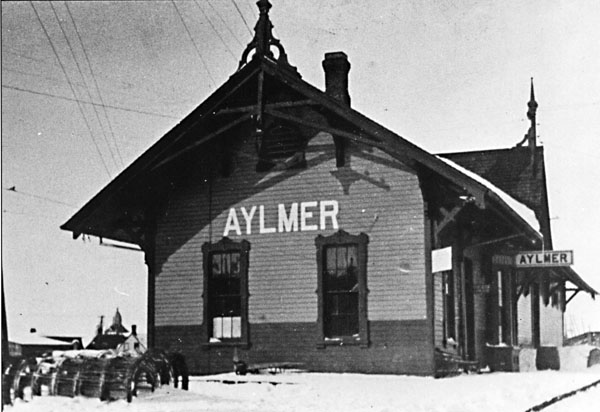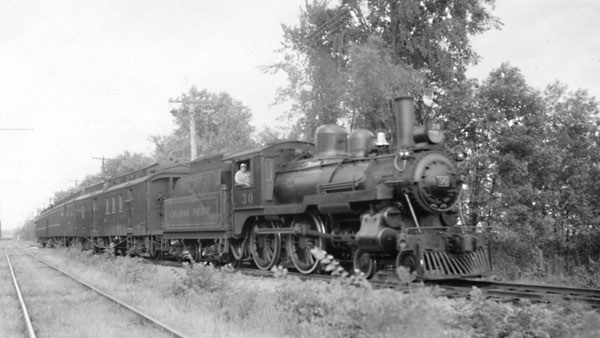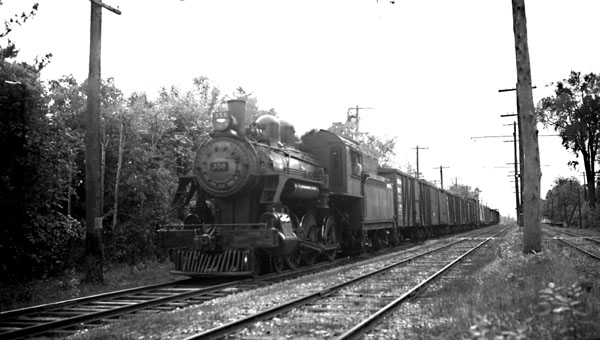The First Railway to Aylmer
One hundred and twenty-five years ago, on 6th
August 1879, the residents of Aylmer, Quebec, were celebrating the arrival
of their railway. It had taken a long time for this important town,
seven miles west of Hull, to become connected to the rapidly expanding Canadian
railway network, and many had despaired that it would ever happen.
Construction
It was the intention to construct the section
between Hull and Aylmer as an extension of a railway along the north shore
of the Ottawa River from Montreal. The surveys for this section had
been completed by 1874 and the Northern Colonization Railway was ready to
start work on the grading. However, there were some delays because
the surveys had not been deposited in the county record office and men did
not get on to the ground until early October 1874 when a large gang of men
was at work near the Hull cemetery, the ground having been broken on 2nd
October near the Aylmer road and close to the toll gate.[1] Grading
started at Aylmer on 26th October.
The pace of construction picked up a little the following year when Councillor Mulligan was awarded a $6,000 contract for 30,000 ties for the section from Aylmer to the Gatineau River bridge. There were complaints that the ties were blocking the principal thoroughfares of Aylmer.[2] By 1876, the work had faltered and Mr. Mulligan had not been paid for his ties[3]. A new contractor, Mr. John MacDonald, was found, and work recommenced in October. He carried out the rock work, mainly near the Hull cemetery,[4] and much of the masonry work was completed along the route.[5] It was still slow going, however, and the masonry work was not completed until the following September although a site for the Aylmer station had been chosen. The pace of the work was determined, to a degree, by the fact that this work was being carried out without direct connection to the rest of the railway network. Supplies could be landed by water in Hull or by rail through Ottawa. Work on the north shore line, now known as the Montreal, Ottawa and Western Railway, was proceeding but there were delays in the completion of the bridge across the Gatineau River. It was proposed to put a locomotive on the Aylmer end of the road for grading purposes.[6] It is not known if this was, in fact, carried out but it doesn’t appear to have been done. The site for the station in Aylmer had been decided upon in July 1877. It was to be located on Main Street near the property owned by Mr. W. Darmady. Grading of this site was completed in October 1877.[7] With the opening of the line from Montreal to Hull on 27th December 1877, the people of Aylmer had some assurance that they would soon be connected to the outside world. 
The Aylmer station in 1910. (Aylmer,
Quebec: Its heritage, son patrimoine” Diane Aldred.
Rail laying did not commence until almost a year
later in August 1878,[8] this time by the Quebec, Montreal, Ottawa and Occidental
Railway (Q.M.O.& O.), a department of the Quebec government. People
were jubilant and the papers were predicting that the people of Aylmer “will
welcome ‘the first snort of the iron horse’”[9] by the end of that
month. As could be expected, the work dragged although people were
still confident that by November they would hear “the grunt of the iron horse”.[10]
By the end of November it was evident that things were not going well
and “the whistle of the iron horse”[11] would not be heard that winter
because the splice bars had not been delivered.
Rails were finally laid into Aylmer on Saturday 2nd August 1879[12] and preparations were made for the official opening on Wednesday 6th August. The first inbound car of freight was received by Mr. Moses Holt on 5th August [13] and the first outbound car, of lumber, was sent by the Aylmer mills on 13th August. [14] The Opening Day
Aylmer City Council voted $100 for a special dinner
to celebrate the opening on 6th August [15]. Mayor Gordon sent the
following telegram to the Ottawa city press and others:
“A grand demonstration is expected here today on the occasion of the opening of the Q.M.O. & O. R.R. extension. About 300 strangers are expected and lunch has been ordered for that many. A band from Ottawa will be present. In the evening it is proposed to have a torchlight procession.” The event was a great success as recorded in the Ottawa Citizen of 8th August 1879: “Wednesday was a red letter day at Aylmer, and it is only natural that it should be for the inhabitants saw the realization of a fond hope that they have nursed in their bosoms for a tenth of century. For a number of years Aylmer has been retrograding. With the construction of the Canada Central on the south shore of the river. She lost control of the great traffic of the upper Ottawa; and in a dozen other ways her trade has diminished down to very narrow dimensions. A new era has, however, dawned, and the silver lining of the dark cloud which has been hanging over her interests is gradually growing more distinct. The "snort of the iron horse" is now heard there and promises in the near future to revive business, and wake the people up from the lethargy which has characterized them of late. The town has now been placed on a line of railway which will doubtless some day form a branch of the great Canadian Pacific, for having extended their road so far, the Provincial Government, in order to secure a fair proportion of the trade of the Northwest, will in all probability continue it to Deep River. The importance of such a connection is quite obvious, and is well understood in the counties of Ottawa and Pontiac. But there is a special reason why the people of Aylmer felt that they should jubilate, a reason which towered above all others, and hat was the fact that the North Shore Railway scheme had its origin among her people and was the outcome of a general meeting of the counties of Pontiac and Ottawa, held there nearly 10 years ago. Its consummation, in so far as that had at that time planned could not but create a spirit of enthusiasm and make them feel commercially speaking that they had been born again. Wednesday, therefore, having been named as the day on which the first passenger train would reach the town, the citizens immediately set to work to arrange a demonstration. They had very little time to work on, and everything had to be gotten up in a hurried manner, but notwithstanding, the affair was a grand success and did not appear at all as if it were impromptu. A committee composed of councillors and citizens was organized and invitations were issued to prominent men of the county who have always manifested a deep interest in the promotion of the scheme. Mr. Scott, General Superintendent of the Western Division of the QMO&O was telegraphed to and shortly before 3 o'clock arrived by special train, accompanied by several gentlemen from the city. THE ARRIVAL
It is safe to say that the whole town and a sprinkling
from the rural area were waiting at the depot, where for half an hour previous
the Hull brass band entertained them with some lively airs. The ladies
turned out in full force and seemed to enthuse as heartily as the "sterner"
sex. By the way, speaking parenthetically, the town boasts of a plethora
of female beauty. The train, at all events, arrived and as it did a
cheer was sent up which showed that the hearts of the people were warm and
their lungs strong. It was what they call
A ZULU CHEER
“nine times nine and repeat. When order
had been restored and the band had got through playing the opening selection,
Mayor Gordon and members of the corporation welcomed Mr. Scott on behalf
of the citizens. Miss Emma Murphy then advanced and presented that
gentleman with an elegant bouquet of flowers. the graceful act being loudly
applauded. Mr. Alonzo Wright M.P. then made a few remarks. After
which a procession was formed, headed by the firemen and their engine and
the band and escorted Mr. Scott and guests to Mrs. Richey's hotel where a
meeting was organized.--
The meeting then retired to the dining room where
Mr. Richey, who is a first class caterer, arranged a sumptuous feast.
The table was beautifully decorated with flowers and the bill of fare was
an extensive one. Mayor Gordon occupied the chair and conducted the
ceremonies with the utmost success. After the cloth had been removed,
the usual loyal toasts were proposed. The health of Mr. Scott and the
Mayor and corporation of Aylmer were given three times three, after which
Mr. Scott offered to run his special to Hull and back with as many citizens
as it could accommodate.
THE TRIP
“The offer was received favourably and about 100
ladies and gentlemen soon found their way to the depot. On their arrival,
considerable excitement was occasioned by an alarm of fire, smoke having
been observed issuing from the south west corner of the station platform.
The planks were quickly pulled up and Mr. N.J. Conroy and the conductor,
with two pails of water, quickly quenched the flames. The train whistled
at 6.45 p.m. and made the run to Hull in about 20 minutes, returning at about
7.20 p.m.
TORCHLIGHT PROCESSION
“The next item on the programme was a torchlight
procession under the direction of the fire brigade. At dark the torches
were ignited and the town paraded. It was a grand success and passed
off without accident.
THE BALL
“This was followed by a ball in Mr. Richey's hall.
There were nearly 100 couples present and they certainly did dance until
"the wee small hours", it being 3 o'clock before the musicians were allowed
to take their departure. It was a very general remark, that although
the ball, like the other part of the programme, had been gotten up in a hurry,
there never was a more successful affair of the kind witnessed in the town.
At midnight a cold collation was served up by Mr. Richey and discussed with
a good deal of energy.”
No arrangements had been made to bring the invited
guests from Hull to Aylmer, several of them managing to hitch a ride on the
special inspection train which consisted of engine and tender, a baggage
car and a first class car. The special trip for Aylmer residents made
the trip to Hull in 23 minutes, going slowly shortly after starting in order
to scare off some cows on the track. Some wag made the comment that
the prospects for plenty of mince meat was good.[16] This seems to
have been a perennial problem for in 1895 a specially trained dog was kept
at the Aylmer station to keep cows away from the track when a train was due.
[17] The ride was good considering that the line had not yet been
ballasted: this work was not started until November.
The first train had to run tender first in one direction as the turntable was not installed at Aylmer until 15th August.[18] An engine house and car shed were also completed at Aylmer by the end of the month.[19] The turntable may not have lasted very long. On 4th March 1893, the Ottawa Citizen reported: “The front of one of the coaches on the Aylmer train was badly smashed yesterday, by the smoke stack of the engine which broke off while the train was going at a good rate of speed. Fortunately no one was on the platform of the coach, for if there had been, a fatality no doubt would have occurred.” The train had evidently been running tender first with the locomotive stack close to the train. 
Canadian Pacific 4-4-0 No. 30 with a passenger train for Aylmer and Waltham in August 1941. This is looking east towards Hull along what is now the Lower Aylmer Road at the intersection of Champlain at Lucerne boulevard. No. 30 was built in September 1887 as No. 1066 and was scrapped in May 1950. Effect of the railway
Particularly after the opening of the bridge across
the Ottawa River to Ottawa, Aylmer became a summer destination both for people
wishing to spend the day in the town as well as those taking a cruise on
a steamer on Lake Deschenes. Aylmer was a very popular destination
for Sunday School outings. Some civil servants made Aylmer their summer
home, travelling to and from Ottawa by train. The train crew became
well known to the passengers as in the following tale from 1881:
“Mr. Jackson, the genial baggageman on the Aylmer branch of the Q.M.O. & O. Railway was presented yesterday with a beautiful pipe and case by the civil service employees, who have been staying in Aylmer during the summer months. Mr. Jackson was rather taken by surprise, but made a suitable reply in thanking the donors for their gift. Mr. W. Aumond made the presentation. Aylmer Times.”[20] 
Subsequent events
The round trip on the opening day was good way of allowing local people to become accustomed to using the train, but Mr. Scott, the Q.M.O. & O. General Superintendent also sent out 300 invitations for a free excursion from Aylmer to Montreal. This took place on 19th August and was a rousing success, the 580 participants, returning shortly after midnight, voted Mr. Scott a right jolly good fellow. [21] Operations soon settled down on this branch which had just the one intermediate station at Belmont, 4¾ miles from Hull. [22] A station at Deschenes was opened in November 1881.[23] The Q.M.O. & O. bridge across the Ottawa river, now known as the Prince of Wales Bridge, was opened on 17th January 1881.[24] The Q.M.O. & O. and Canada Central Railways built a union depot at Ottawa, Chaudiere, and the Aylmer trains started to run into this station by 6th June 1881.[25] The Canadian Pacific Railway purchased the Q.M.O. & O. on 3rd June 1882 and thus Aylmer came under the influence of the C.P.R. On 9th December 1884, another railway, the Pontiac and Pacific Junction Railway (P. & P. J.) opened its line from Aylmer to Quyon. This company, which eventually reached as far as Waltham, built a second engine house and a locomotive and car shop at Aylmer. The Gatineau Valley trains, locomotives and cars were also maintained at the P. & P. J. at Aylmer. The P. & P. J. was continually hamstrung by the C.P.R. which controlled its access to the outside world. There were rumors at various times in the 1890’s that the P. & P. J. would buy the Aylmer branch and legislative approval was even obtained. However, it was a new company, the Hull Electric Railway (H.E.R) which gained control over the C.P.R. Aylmer branch, first by lease, on 21st March 1896, and then by outright purchase on 9th January 1899. The P. & P. J. attempted to run its trains over the Hull Electric but the schedules were very restrictive because the H.E.R., by now double tracked, was running a regular interval streetcar service. The P. & P. J. was thus forced to build its own line from Aylmer into Hull, which was opened on 2nd December 1901. The P. & P. J. became part of the Ottawa, Northern & Western in 1902 which subsequently became part of Canadian Pacific. Subsequent events are somewhat more sanguine: Aylmer people were often regarded as different and the railway treated them differently at times as is illustrated by this extract from the Ottawa Citizen of 28th January 1901: “Passengers from Aylmer who board a train without
a ticket are charged an extra 25 cents. The reason for this is the
large number of people boarding at Aylmer without a ticket and who argue
about the fare until their destination is reached. People boarding
at flag stops are not charged anything extra while those boarding at other
stations without tickets are charged an extra 10 cents."
|